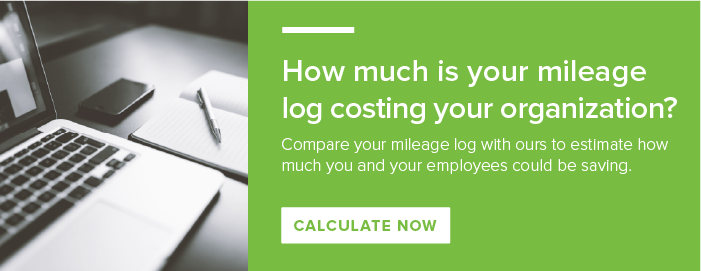Mileage logs are necessary if you pay a mileage reimbursement or fuel reimbursement. The type of mileage log you use can significantly increase or decrease company costs.
How much a company mileage log can cost
Mileage logs can come in many different forms. Some will add to company expenses while others can actually help rein in expenses.
- Excel mileage spreadsheet - Many organizations elect to have employees input their mileage using Excel spreadsheets designed to include trip date, location, purpose, and mileage with calculations.
- Google Sheets mileage log - Google Sheets can be designed to perform the same operations as Excel spreadsheets but may interface better with organizations that use Google Suite products.
- Expense management system - Many companies purchase software to manage employee expenses and reimbursements. These systems may include an electronic mileage log for manual reporting or some kind of mileage tracking app to record mileage and trip information.
- Mileage tracking app - Dozens of GPS-based mileage tracking apps now exist that can be used on their own or as part of a corporate expensing or reimbursement system.
Whether the mileage log your organization chooses costs you money or saves you money will depend on how much manual reporting is involved and how much visibility the system provides into employee productivity.
Self-reporting and costly mileage logs
The biggest factor in how much your mileage log will cost the company is the amount of manual reporting involved. Spreadsheets like Excel, Google Sheets, and other electronic mileage logs all share this weak spot.
The more mileage employees report, the more money they are paid. It is that simple. Any organization would ideally operate on a system of trust. But there are a number of reasons why an honor system does not work when it comes to reporting business mileage.
1. Mileage spreadsheets are prone to estimations.
Entering trip information and mileage manually is time consuming. It makes sense to estimate mileage and assume it will even out. It is also easy to use Google Maps to estimate mileage, which may or may not reflect the actual trip mileage. When people estimate, they tend to round up, and over the course of time in a large company that can add up to a major expense.
2. Self-reported mileage incentivizes overreporting.
When you are an employee working hard and trying to support yourself or a family, it is easy to justify padding your reported mileage amounts. This is especially true when vehicle costs increase quickly over time, as they did when gas prices spiked in early 2022. Inflation in car prices, insurance rates, and maintenance costs can also motivate employees to protect their income by inflating their reported business mileage.
3. Manual mileage logging is prone to errors.
It is not hard to make a mistake when entering numbers into a spreadsheet. Management does not have the time to check each submitted mileage report carefully for errors. It is possible that errors could even out over time, but is it worth the risk of yet another source of empty mileage reporting?
Visibility into business travel and mileage logs
An increase in reported mileage over time may not be a problem if it represents an increase in productive business travel that earns more money for the organization. But how do you know whether an increase in mileage reports is legitimate or caused by "guesstimation," mileage buffering, or errors?
You could carefully examine each employee's trip log and compare these trips with the employee's performance over time. But this laborious process can be accomplished if your mileage capture system is integrated with your CRM system or other system for tracking the results of employee's business travel in terms of sales, customer satisfaction, etc., depending on the employee's role.
Chances are, your spreadsheet mileage log does not integrate in this way, making productivity comparisons too time-consuming to carry out.
Automated mileage logs and cost control
Today's mileage tracking apps can reduce manual reporting of mileage and provide greater visibility into employee performance. Many of these mobile apps have "set it and forget it" capabilities so that mileage is automatically tracked when the vehicle starts moving. Or drivers can turn on the tracker at the beginning of a business trip.
The key considerations when choosing a mileage tracking app are
- Employee privacy protection (real-time recording without real-time reporting)
- Integration with company reimbursement system and CRM software
- Ease of use, technical support, and reliability
If your organization currently pays reimbursements using a mileage log that involves self-reporting, you could save money by switching to an automated system. mBurse offers a 30-day free trial of mLog, its mobile app that protects privacy while delivering accurate mileage capture.

